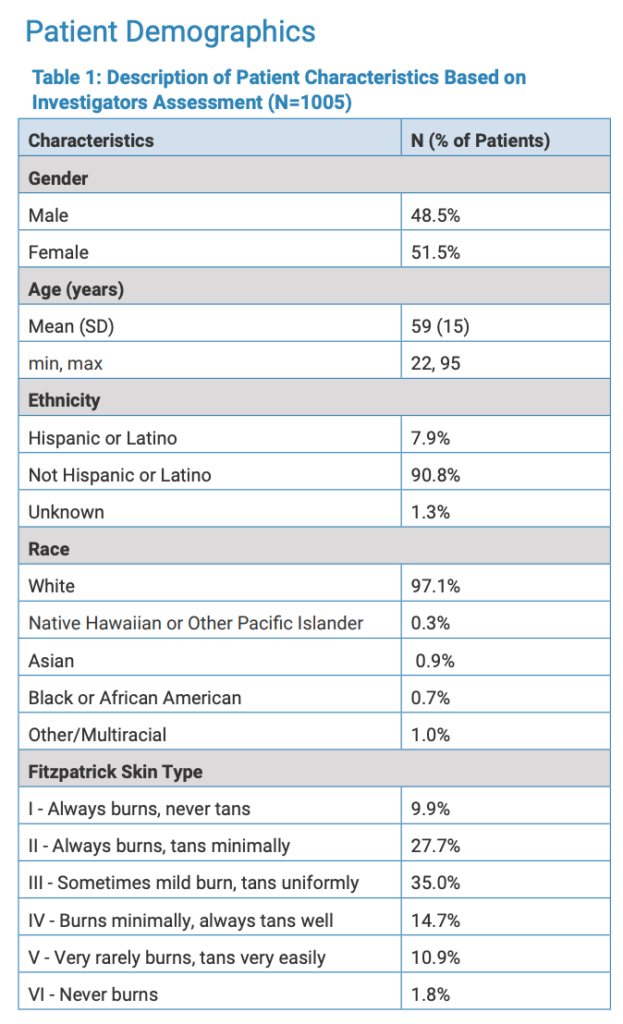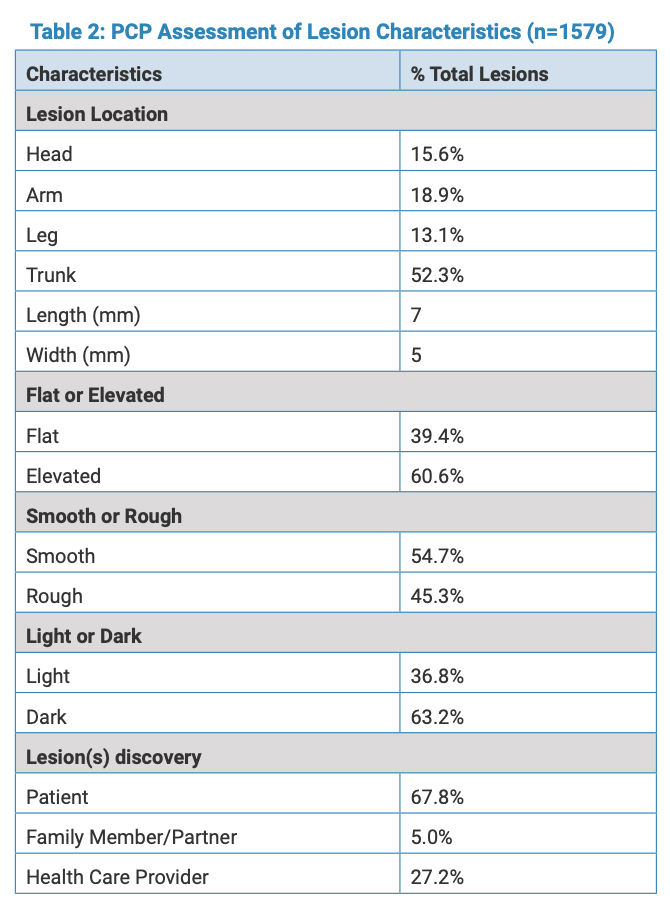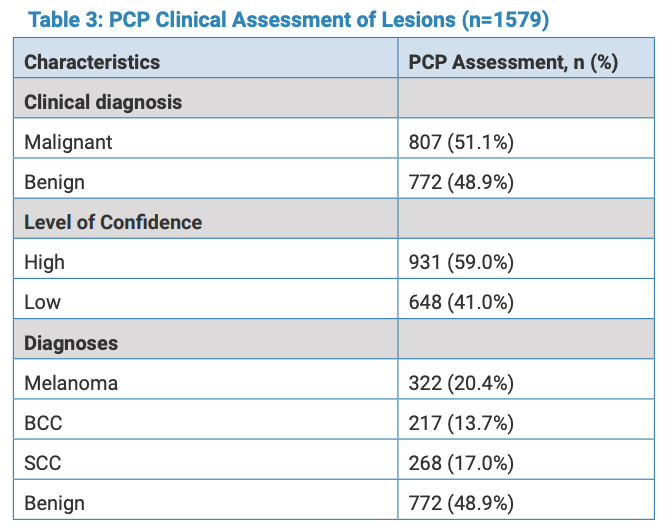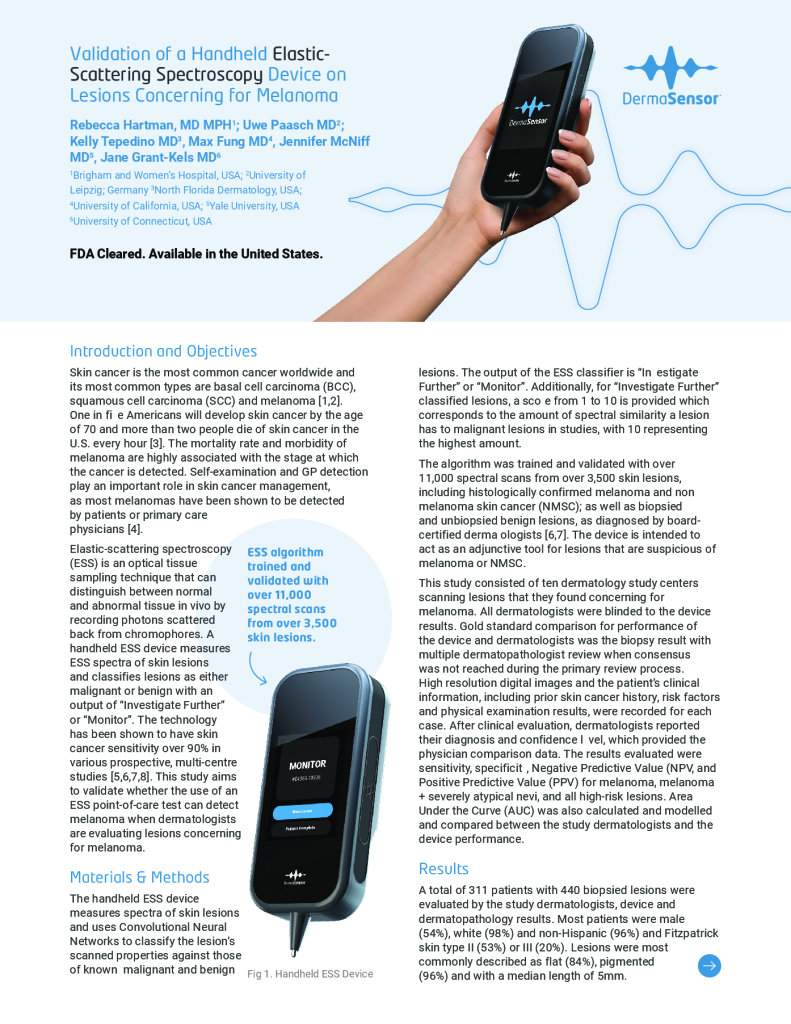Background and Objective
Skin cancer is by far the most common type of cancer in the United States [1]. The most common types of skin cancer are basal cell carcinoma (BCC) and squamous cell carcinoma (SCC) followed by melanoma [1,2]. In the United States, it is estimated that there will be 5.4 million new cases of nonmelanoma skin cancer (NMSC), 100,000 new cases of invasive melanoma and another 100,000 cases of melanoma in situ diagnosed annually [1].
Primary care providers (PCPs) have demonstrable difficulty in identifying skin lesions in need of further evaluation [3]. Access to a dermatologist for diagnosis and management of skin cancer is challenging, as around 40% of the United States population live in areas that have limited access to a dermatologist [4]. Leveraging technology may aid PCPs in improving skin cancer detection and corresponding referrals, thereby reducing associated mortality and morbidity and the burden on the healthcare system.

Elastic Scattering Spectroscopy (ESS), an optical tissue sampling technique, distinguishes between normal and abnormal tissue in vivo without the need to remove tissue. Measuring the ESS spectra of skin lesions, a novel handheld device classifies lesions as either high risk or low risk for malignancy with an output of “Investigate Further” or “Monitor”. The technology has been shown to have skin cancer sensitivity over 90% in various prospective, multi-center studies when compared to gold-standard dermatopathology results [5,6,7].
This study investigated the sensitivity and specificity of a noninvasive, hand-held ESS device in evaluating skin lesions compared to the in-person clinical evaluation by PCPs.
Materials & Methods
The handheld ESS device (Figure 1) measures spectra of skin lesions and uses an algorithm to classify the lesion’s scanned properties against those of known malignant and benign lesions, providing an output of “Investigate Further” or “Monitor”, respectively. Additionally, for “Investigate Further” classified lesions, a score from 1 to 10 is provided which corresponds to the amount of spectral similarity a lesion has to malignant lesions in studies, with 10 representing the highest amount.
The algorithm has been trained and validated with over 20,000 spectral scans from over 4,500 skin lesions, including histologically confirmed melanoma, BCC, SCC and benign lesions as well as unbiopsied benign lesions diagnosed by board-certified dermatologists.
This blinded, prospective, multi-center study was conducted at 22 primary care study sites across the United States (18 sites) and Australia (4 sites). Patients with lesions suggestive of skin cancer were clinically assessed by PCPs and then evaluated by the ESS device. Patients and PCPs were blinded to device output. All lesions enrolled were biopsied per physician assessments and standard of care. Each lesion’s diagnosis involved 2-5 dermatopathologists, dependent on pathology and discordance. Statistical analyses after study unblinding included standard diagnostic test parameters of the device for detecting skin cancer as well as the influence of lesion and patient factors on device performance.
Patient Enrollment
Patients were enrolled from 22 sites, with 18 sites in the US and 4 in Australia by primary care providers. During study enrollment, five lesions (0.3%) were excluded due to device data capture issues and five lesions (0.3%) due to lack of dermatopathology consensus (Figure 2).
There were no adverse events related to device use.
A total of 1,005 patients with 1,579 lesions suggestive of skin cancer were enrolled. Among the patients enrolled, 51.4% were female with a mean age of 59 years, and 72.5% of patients were Fitzpatrick Skin Type I-III. (Table 1)


Lesion Characteristics
The majority of lesions were located on the trunk (52.3%). Average size of enrolled lesions was 7mm x 5mm. The majority were elevated, smooth and dark. Most lesions were identified by the patient (67.8%) and only 27.2% were identified by a healthcare provider. (Table 2).
The PCPs diagnosed 807 lesions as “malignant”, of which 322 were classified as “melanoma” (Table 3).


Dermatopathology evaluation confirmed 224 high risk lesions: 48 melanomas (including highly atypical nevi), 90 basal cell carcinomas and 86 squamous cell carcinomas (Table 4).

Device Effectiveness Results
PCPs had an overall sensitivity of 83.0%, while the ESS device had an overall sensitivity of 95.5% (p<0.0001). The overall specificity of the device was 20.7% for correctly classifying benign biopsied lesions. The NPV of the device for a ‘Monitor’ result was 96.6% and the PPV for an ‘Investigate Further’ result was 16.6% (NNB of 6:1). The sensitivity + specificity logistic regression model was statistically significant with an odds ratio of 4.93 (95% CI: 2.84-8.5, p<0.0001). For spectral scores of 1-3, the associated PPV was 5.9% (NNB 16.9) and this increased to 39.6% (NNB 2.5) for scores of 8-10.
Conclusion
The novel hand-held ESS device demonstrated high sensitivity in detecting skin cancer when compared to the gold-standard of histopathologic examination. Use of this device has the potential to improve PCP sensitivity for skin cancer from 83.0% to 95.5% for high-risk lesions. Coupled with clinical exam findings, this device may aid PCPs to improve clinical decisions about suspicious skin lesions (i.e., to refer, or monitor), with this study suggesting device use could rule out 20.7% of suspicious lesions from needing further evaluation. This highly sensitive, noninvasive, hand-held ESS device may fill a well recognized void in PCP dermatologic care by providing an objective, point-of-care test for clinical assessment. This device may help increase quality of referrals to dermatology by providing PCPs with an additional instrument to assess lesions for skin cancer risk.
References
- Siegel R et al. Cancer statistics, 2023. CA Cancer J Clin 2023:73(1):17-48.
- “American Cancer Society. Key Statistics for Basal and Squamous Cell Skin Cancers,” 2023. [Online]. Available: www.cancer.org/cancer/basalandsquamous- cell-skin-cancer/about/key-statistics.html. [Accessed 13 February2023].
- Chen SC, et al. A Comparison of Dermatologists’ and Primary Care Physicians’ Accuracy in Diagnosing Melanoma. Arch Demal. 2001;137:1627- 1634.
- Dinnes J, Deeks JJ, Grainge MJ, et al. Visual inspection for diagnosing cutaneous melanoma in adults. Cochrane Database of Systematic Reviews. 2018;12:CD013194.
- Hester T, et al. Increasing Access to Specialized Dermatology Care: A Retrospective Study Investigating Clinical Operation and Impact of a University- Affiliated Free Clinic. Dermatol Ther (Heidelb). 2021;11(1):105- 115.)
- Rodriguez-Diaz E, et al. Optical Spectroscopy as a Method for Skin Cancer Risk Assessment. Photochem Photobiol. 2019;95(6):1441-1445.
- Manolakos D, et al. Clinical Validation of a Handheld Elastic Scattering Spectroscopy Artificial Intelligence Device. Podium Presentation, American Academy of Dermatology Innovation Academy, Vancouver, CA, July 20-24, 2022.
- Hartman R, et al. Validation of a Handheld Elasticscattering Spectroscopy Device on Lesions Suggestive of Melanoma. J Dermatol Physician Assist. 2022 Fall; 16(4):51.
Disclosures
This study was funded by DermaSensor, Inc. Dr. Leffell is a Scientific Advisory Board member for DermaSensor has a commercial interest in the company, and Drs. Nguyen and Chatha are employees of DermaSensor Inc.
Adapted from Merry SP, McCormick B, Nguyen VL, Chatha K, Croghan I, Leffell D. DERM-SUCCESS: Clinical Validation of an Elastic Scattering Spectroscopy (ESS) Device in Assisting Primary Care Physicians’ Detection of Skin Cancer. Poster Presentation, Maui Derm NPPA Conference, Asheville, NC, Sept 23-25, 2023.


